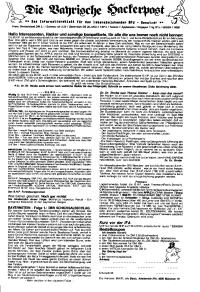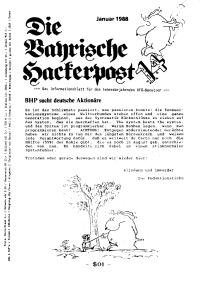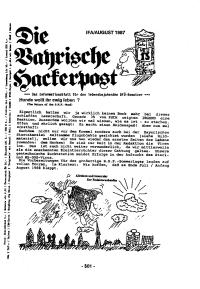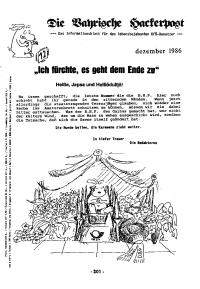Copy Link
Add to Bookmark
Report
HOMEBREW Digest #2899

HOMEBREW Digest #2899 Sat 12 December 1998
FORUM ON BEER, HOMEBREWING, AND RELATED ISSUES
Digest Janitor: janitor@hbd.org
Many thanks to the Observer & Eccentric Newspapers of
Livonia, Michigan for sponsoring the Homebrew Digest.
URL: http://www.oeonline.com
Contents:
Al K's Book (Badger Roullett)
Gott (Christopher "R." Hebert)
RE: Liquid Smoke (The Brew Company)
RE: LD Carlson Fruit Flavoring (The Brew Company)
Waffles (Christopher "R." Hebert)
Homebrew kegging? (Brian Morgan)
filling bottles from kegs ("Darren Robey")
Things growing in my moist freezer ("Kensler, Paul")
Philmills (Dan Listermann)
Temp reguln: ferment, 2ary, bottles (Ian Lyons)
Re: Books Under the Xmas Tree ("Robert J. Waddell")
Grain Mills/air space ("Rob Jones")
Converted keg mash tun ("Robert Phelan")
Re: Storing yeast vials. (Ross Reid)
lawyers, guns and money (AlannnnT)
Low Carbonation in high gravity beers (Jim Welsh)
Brew room setup ("Sandy Macmillan")
It is braging and it is bashing ("Rick Wood")
Water Treatments for Munich Dark Beers (Ted McIrvine)
Protein rest (ThomasM923)
All the beer in Deutschland ... (The Greenman)
Re: Books Under the Xmas Tree (Scott Murman)
Another Grain Mill opinion (Jim Grady)
Re: Grain Mill (John Murphy)
Re> Chris Pittock's Questions ("Penn, John")
pr: zum uerige ("Alan McKay")
Dixie Blackened Voodoo Lager -- Worst Beer Ever? (Michael A. Owings)
pr : zum uerige and the German "R" ("Alan McKay")
on evacuating cornie kegs ("Nathaniel P. Lansing")
Homebrewing information on the HBD page... (pbabcock)
craft beer in the 21st century (Vachom)
Christmas present for the server... (pbabcock)
fusels ("Nathaniel P. Lansing")
Beer is our obsession and we're late for therapy!
//////
(This space free to a good competition)
//////
NOTE NEW HOMEBREW ADDRESS: hbd.org
Send articles for __publication_only__ to post@hbd.org
If your e-mail account is being deleted, please unsubscribe first!!
To SUBSCRIBE or UNSUBSCRIBE send an e-mail message with the word
"subscribe" or "unsubscribe" to request@hbd.org.
**SUBSCRIBE AND UNSUBSCRIBE REQUESTS MUST BE SENT FROM THE E-MAIL
ACCOUNT YOU WISH TO HAVE SUBSCRIBED OR UNSUBSCRIBED!!!**
IF YOU HAVE SPAM-PROOFED your e-mail address, the autoresponder and
the SUBSCRIBE/UNSUBSCRIBE commands will fail!
Contact brewery@hbd.org for information regarding the "Cat's Meow"
Back issues are available via:
HTML from...
http://hbd.org
Anonymous ftp from...
ftp://hbd.org/pub/hbd/digests
ftp://ftp.stanford.edu/pub/clubs/homebrew/beer
AFS users can find it under...
/afs/ir.stanford.edu/ftp/pub/clubs/homebrew/beer
COPYRIGHT for the Digest as a collection is currently held by hbd.org
(Pat Babcock and Karl Lutzen). Digests in their entirity CANNOT be
reprinted/reproduced without this entire header section unless
EXPRESS written permission has been obtained from hbd.org.
COPYRIGHT for individual posts within each Digest is held by the
author. Articles cannot be extracted from the Digest and
reprinted/reproduced without the EXPRESS written permission of the
author. The author and HBD must be attributed as author and source
in any such reprint/reproduction. (Note: QUOTING of items
originally appearing in the Digest in a subsequent Digest is
exempt from the above.)
JANITORS on duty: Pat Babcock and Karl Lutzen (janitor@hbd.org)
----------------------------------------------------------------------
Date: Thu, 10 Dec 1998 12:01:49 -0800
From: Badger Roullett <branderr@microsoft.com>
Subject: Al K's Book
> From: JPullum127@aol.com
>Subject: richards scotts book query
> i'd strongly reccomend al korzonas homebrewing vol 1. not sold in stores ,
> but available on his website. an excellent book with many very usefull
items.
> you can get an idea of his knowledge from his articles on hbd. far more
> usefull than homebrewing for dummies. i can't wait for vol 2. have
fun
I also would recomend Al K's Book. I also would really really love to see
Vol. 2 in the works!!! C'mon Al, you can do it! ;)
I have another suggestion though. The book is not really sold in stores,
and it should be. Why don't we all (those of us who like it, and want to
support a good book, and a good author) go down to our suppliers/home brew
shops/grain temple and tell them about it and encourage them to stock it.
Spread the word... I found it much more informative, and useful than
Papazian's book (although he does deserve some respect for his work) and
recomend it to my freinds.
I have no connection to Al, (although I have his link on my Amazon.Com
Bookstore website, so i get a few pennies if you buy the book through my
website).
Badger
***************************************************
Brander Roullett aka Badger
Homepage: http://www.nwlink.com/~badger
In the SCA: Lord Frederic Badger of Amberhaven
"It had to be a linguistics professor who said that it's man's ability to
use language that makes him the dominant species on the planet. That may
be. But I think there's one other thing that separates us from animals. We
aren't afraid of vacuum cleaners." --Jeff Stilson
------------------------------
Date: Thu, 10 Dec 1998 14:33:44 -0700
From: Christopher "R." Hebert <CRH@ny.rfny.rflaw.com>
Subject: Gott
I bought my 5 gal Gott when I started doing all-grain. Before that, when I
did partial mashes, I used a collender! No vorlauf, burnt fingers and lots
of hot-side aeration. Yum. Personally, I think if you got a 10-gallon Gott
and used it for partial mashes, the benefits of increase extraction and
clear runoff would outweigh any problems you'd encounter with a
less-than-ideal grain bed depth. To me, some things are more important
than others...having a clear runoff while sparging, for example, is
probably something to be more concerned about than, say, grain bed
depth or pH or brewing salts.
I say, go for the 10-gallon Gott.
------------------------------
Date: Thu, 10 Dec 1998 16:57:20 -0500 (EST)
From: The Brew Company <sales@brewcompany.com>
Subject: RE: Liquid Smoke
Dave writes:
>I have a recipe calling for adding liquid smoke when bottling.
>
>How should I do this? Just add it (2 tablespoons) to my bottling bucket?
>Boil it along with my priming sugar?
Personally, I wouldn't use it. Over the weekend I judged at a local
competition and came across a smoked beer. It was very obvious that the
person used Liquid Smoke for the smoke flavor, and it didn't blend well.
It was like taking a sip of beer, swallowing, then added a tiny drop in
your tongue.
If you want a smoked brew, I would use smoked malt, about 1/2 to 1 lb.
This is not to be confused with smoked peated malt, I have never used it,
but have heard many horror stories about it. I made a smoked porter with
1/2 lb of the smoked malt ant it turned out real nice. Many raves at a
local hb club mtg.
If you still decide to go for it, I would add it at bottling, *after*
experimenting with a few samples first. ;-)
-Skill
-------------------------------------------------------------------------
The Brew Company of Carlisle 717-241-2734
152 South Hanover Street (fax) 717-241-2735
Carlisle, PA 17013 www.brewcompany.com sales@brewcompany.com
-------------------------------------------------------------------------
------------------------------
Date: Thu, 10 Dec 1998 16:57:28 -0500 (EST)
From: The Brew Company <sales@brewcompany.com>
Subject: RE: LD Carlson Fruit Flavoring
Jeff writes:
(stuff deleted)
>I have two options: add the flavor when I rack to secondary or add it at
>bottling.
I would add it at bottling. These are the small bottles, right? Like 2
ounces? I have seen these recommend using the entire bottle for a 5
gallon batch but, I would start out small and work my way up. Add 1/4
bottle in the bottling bucket, stir and taste. Add another 1/4, etc.
If you add too much initially, you're hosed.
I wouldn't be concerned about the sugars that are included with the
flavoring.
-Skill
-------------------------------------------------------------------------
The Brew Company of Carlisle 717-241-2734
152 South Hanover Street (fax) 717-241-2735
Carlisle, PA 17013 www.brewcompany.com sales@brewcompany.com
-------------------------------------------------------------------------
------------------------------
Date: Thu, 10 Dec 1998 15:11:21 -0700
From: Christopher "R." Hebert <CRH@ny.rfny.rflaw.com>
Subject: Waffles
In light of Al K.'s post on Fries, I'd like to point out that the Flemish are
incorrectly attributed in the production of Belgian Waffles. These
creatures were introduced at the 1964 NY World's Fair and, then, called
Bel-Gem Waffles. Kind of a French (why? I don't know) Beauty thing, I
suppose. But, those Noo Yawkers...Bel-Gem quickly became Belgian
and then there was no turning back...
Chris in Brooklyn, NY.
------------------------------
Date: Fri, 11 Dec 1998 06:40:01 +1100 (EST)
From: Brian Morgan <bkm_42@yahoo.com>
Subject: Homebrew kegging?
I've made several batches of ale (and liked them all...), and am
interested in kegging my next batch. I have a CO2 setup for
commercial barrels - what I'd like to do is put my next batch directly
in the barrel from the fermenter, then use the CO2 to carbonate it
(instead of sugar, reactivating the yeast, etc). I know that's
probably considered sacrilege here... But how do I do it? Just fill
the excess space in the barrel with CO2 under pressure, and let the
beer absorb it? How long would it take, and what kind of pressure
would it take?
Thanks!!! And Happy Holidays!
Brian Morgan
bkm_42@yahoo.com
_________________________________________________________
DO YOU YAHOO!?
Get your free @yahoo.com address at http://mail.yahoo.com
------------------------------
Date: Fri, 11 Dec 1998 09:29:09 +1000
From: "Darren Robey"<Darren.Robey@nre.vic.gov.au>
Subject: filling bottles from kegs
I know such newbie questions can get a little bornig, but any advice would
be helpful.
I've been kegging for a little while now, but still like to fill some
bottles for taking with me when I don't want to cart a keg around. Now I
haven't got a CPBF at all, but I was after any advice for filling with my
normal beer gun.
Any advice Very much appreciated!
Darren Robey
------------------------------
Date: Thu, 10 Dec 1998 16:33:32 -0600
From: "Kensler, Paul" <paul.kensler@wilcom.com>
Subject: Things growing in my moist freezer
Hello all,
Some may remember several posts a couple of weeks ago, about reducing
moisture in chest freezers by using a desiccant. I have had no luck with
either kind (the pink crystal kind in a tub, or the dirt kind in a bag), so
I have resigned myself to having a moist freezer.
However, I still harbor some hope that I can somehow retard or eliminate the
resulting mold growth. I keep the freezer at 33F, and am very careful not
to spill beer (ie, nutrients) inside the freezer, but I still have a thick,
nasty, black carpet on the bottom of the freezer - it almost looks like the
algae carpet you get in freshwater aquariums. The one and only time I
raised the temperature (for lager fermentation), the mold grew like crazy.
My question: Is there any sort of anti-fungal / anti-mold / anti-mildew
treatment or product I can use to retard the growth of nasty stuff? Or do I
just need to add the monthly emptying / cleaning of the freezer to my list
of chores?
For what its worth, I don't often open the chest freezer (allowing more
humid air in), and I have a typical wood collar around the top (pine 2x10
boards sealed at the joints with silicone).
Any suggestions welcome.
Thanks,
Paul Kensler
-Protesting moldy puddles in Plano, TX
------------------------------
Date: Thu, 10 Dec 1998 18:04:08 -0500
From: Dan Listermann <72723.1707@compuserve.com>
Subject: Philmills
Tidmarsh Major had some comments about the Philmill that I would like to
address.
The reason that the Philmill clamps to a table is that I found mills that
were mounted on top of buckets, while apealing on the surface, were
difficult to hold down while cranking.
The hopper ( a two liter pop bottle ) is very servicable and easily and
inexpensively acquired. I prefer a three liter bottle, but they are not
universally available and require a larger mounting hole. We can supply
a
mounting block with a larger hole or anyone can make one using a 1.5 dia.
hole saw. An adapter that can be screwed to the existing mounting block
can be made the same way.
Another alternative is to simply construct a hopper and screw the mill to
it. A 5 gallon plastic carboy is a fantastic hopper that will easily
hold
20 lbs of malt.
I encourage motorizing the Philmill especially with a common 1/2"
electric
hand drill. The later models need a headless 3/8" shoulder bolt (
stripper
bolt ) to adapt it to power. We also sell these. The mill does eject
grist at an angle from vertical. The best way to control this is to
construct a funnel with another two liter pop bottle. Cut the bottom
out,
poke a hole for the crank shaft and another at 90 degrees for the
adjustment screw. Simple hang the funnel from these holes and the grist
will fall vertically with very little dust in a one inch diameter stream.
If one must have a two roll mill, just wait a little while. The best is
yet to come.....
Dan Listermann dan@listermann.com
------------------------------
Date: Fri, 11 Dec 1998 10:40:31 +1030
From: Ian Lyons <ilyons@biochem.adelaide.edu.au>
Subject: Temp reguln: ferment, 2ary, bottles
Dear collective wisdom
There's been a little bit of chat about the (lack of ) welcome for
beginners in this news group. As such a beginner let me thank you for the
welcome and the help and info flow I have received over the last few
months. During that time I have been advised on the malting and kilning of
grain, mash brewing, and have even skimmed through the esoterica of laminar
flow through grain beds.
The upshot is that I have just opened my first mash brewed beer, a pilsner
and have been rewarded for all the effort! Great texture: mouth feel and
head retention. Aromatic, firm hop finish. AND it's only been in the
bottle 3 weeks. I expect it to integrate and soften more over the next
couple of months.
(BTW: 5kg pale malt (stepped stove top mash, and first up mash efficiency
of 85%!), 90g Saaz hops x 60 minutes boil, ferment 8-12oC, RO water to
emulate pilsn water, and SAFLAGER dried yeast bcs the Wyeast bohemian
starter smelt funny).
Here's the next round of questions:
Even though I can control the primary ferment, the technology I have
requires a secondary at ambient (15-25oC depending on season). Is this a
problem?
Tell me more about diacetyl rest? I'm reading about it, but I don't get it!
After bottling 'pilsner' I don't have any deep caves to lager it in. Again
storage is a problem. Typically I have stored my brews outside the house,
which in South australia at this time of year is 15-42oC! what is the
likely effect of this? How desparately should i fight for inside storage
space?
thanks again for past (and future) advice!
Ian Lyons
ilyons@biochem.adelaide.edu (DOT au, bcs that's where I am)
Ian Lyons
BresaGen Cell and Molecular Biology Laboratory
Department of Biochemistry
The University of Adelaide
Adelaide
South Australia
AUSTRALIA 5005
Phone 61 8 8303 5353
FACS 61 8 8303 4348
ilyons@biochem.adelaide.edu.au
------------------------------
Date: Thu, 10 Dec 1998 17:38:00 -0700
From: "Robert J. Waddell" <rjw@dimensional.com>
Subject: Re: Books Under the Xmas Tree
"Chuck Bernard" <bernardch@mindspring.com> wrote:
>Back to the request. . . If I could only keep two HB books from my
>library, they would be (in no particular order)
>"Designing Great Beers," by Ray Daniels
>"Homebrewing - Volume I," by Al Korzonas
Great choices Chuck, and I'd like to add one more. When I attended the
"World Beer Forum" at the GABF this year (sponsored by the Keg Ran Out
Club) I won a door prize that was donated by Brian Rezac of the AHA. It
was the book: Beer In America/ The Early Years--1587-1840, written by Gregg
Smith. It was one of the best reads of non-fiction that I've ever read.
It gave me plenty of ammunition to use against the liberal nannies and the
ultra-right wing Bible thumpers. Being a (sometimes rabid) patriot, it
really justified my philosophy concerning brewing and consuming what I
brew. (If anyone feels the urge to debate my politics, let's do it
off-line) #%^)
Just wanted to cast a vote, and explain why.
RJW
I *L*O*V*E* my [Pico] system. 'Cept for that
gonging noise it makes when my wife throws it
off the bed at night.
Women...
--Pat Babcock
*** It's never too late to have a happy childhood! ***
********************************************************************
RJW@dimensional.com / Opinions expressed are usually my own but
Robert J. Waddell / perhaps shared. ICQ #7136012
Owner & Brewmaster: Barchenspeider Brew-Haus Longmont, Colorado
********************************************************************
(4,592 feet higher than Jeff Renner)
------------------------------
Date: Thu, 10 Dec 1998 21:24:59 -0600
From: "Rob Jones" <robjones@pathcom.com>
Subject: Grain Mills/air space
I'd like to put a plug in for the Canadian made Valley Mill. I've used one
at a friend's BOP, and it does a great job every time. Has two fully
adjustalble knurled rollers and is easily motorized.
Herb writes about the best crush being somewhere between settings... we've
found that the best crush is obtained buy slightly undercrushing on the
first run, then jumping up one notch and running the grist through again.
This appears to maximize the grain crush but minimize the husk damage.
(Not affiliated, just pushing made in Canada. We've got to be able to
compete within NAFTA somehow! Oh yeah, there is that wheat dumping thing as
well...)
Concerning air space... when I've been feeling particularly anal about
oxidation, which usually involves my lambics that are in the bottle for a
few years, I've attached a picnic tap to my gas line. I shoot a little CO2
into each bottle before filling and hopefully purge some of the O2. I keep
the regulator pressure low in hopes that the CO2 doesn't just blast into
then straight out of the relatively small space. Otherwise I don't worry
about, and have never had a problem.
When using my CPBF I try to get just enough foaming to effectiviely cap on
foam.
Rob Jones,
Toronto
------------------------------
Date: Thu, 10 Dec 1998 18:43:07 PST
From: "Robert Phelan" <rephelan@excite.com>
Subject: Converted keg mash tun
I need a little help. Every converted keg mash tun I'vve seen uses a false
bottom or equalilent with some sort of bottom to side siphon for extraction.
My basic question is, WHY?
Wouldn't simply draining straight out the bottom of the tun work just the
same? If not, why not?
Some friends of mine opperate a small micro here in town using a converted
milk vessel (about 1250 gals) as a mash tun and drain from the bottom
through 2 "v" screens. Seems to work well for them.
Has anybody tried bottom drainig from a mash tun? All thoughts would be
appreciated before I cut my kegs into scrap metal.
Thanks
_______________________________________________________
Get your free, private e-mail at http://mail.excite.com/
------------------------------
Date: Fri, 11 Dec 1998 02:52:40 GMT
From: mrreid@golden.net (Ross Reid)
Subject: Re: Storing yeast vials.
In HBD#2895 Scott Murman asked for an inexpensive convenient way
to store his large collection of 1 dram vials.
As well as a home brewer, I have also been a reloader. For a
good, secure, sturdy storage container, I'd suggest trying a gun
shop. There are several manufacturers of polycarbonate ammunition
boxes with individual spaces for various sized cartridges. MTM is
a good one that comes to mind. While I have no idea of the size
of a 1 dram vial, there should be an ammo box that will fit them.
Some of the MTM boxes have hinged lids and hold 50 cartridges.
Cheers,
Ross.
------------------------------
Date: Thu, 10 Dec 1998 23:07:43 EST
From: AlannnnT@aol.com
Subject: lawyers, guns and money
Hi all,
About site glasses. Wouldn't it make a great fund raiser for the HBD? We could
make barware with the HBD slogan, or t's or mash paddles or something. (For
the next major computer hardware purchase.)
My choice for slogan? "I live 500 miles from Jeff Renner"
Or "It's clinitest or no test at all"
Or "Botjulism- If you can't spell it, it can't Hurt you"
Or "Malt Mills cure Alcoholism"
Or, maybe just "post@hbd.org"
Answers to a few postings;
Someone posted that Al K's book is not available in stores. Hogwash! Many
homebrew stores carry it. As well they should.
RE: Fruit extracts containing fermentables. Even if LD Carlsen's extract does
have a small percentage of fermentable sugar, it should not effect bottle
conditioning. With the experience of many hundreds of fruit extract beers,
I've never had a complaint or problem reported to me, in my shop.
Co2 and air and oxygen. Sometimes posters seem to have trouble with the idea
of heavy CO2 and lighter O2 and all that. Let's think of it this way- If gases
didn't mix all the time, we'd all be dead. All the heavy gases would be down
here with us. All the light oxygen would be up there, where the birds go. One
good volcano eruption would kill us all.
All this talk about homemalting makes me want to point this out. Malting rye
at home can be dangerous. I have checked this out in a few published sources
and they all say the same. There is a toxic spore you can grow on rye, and
it's allegedly very toxic. I hate to be so vague here. Maybe Al K. can help
with more specifics.
- ------------------------------
Michael Jackson, beer writer, not the other one, was on Conan Obrien last
night. I feel privileged and honored to one of the very few people on the
planet to have tasted both of the beers that MK opened for sampling. One was
Brooklyn Chocolate Stout. In case you don't know, that's the dessert beer
served in Heaven. Made by Garett Oliver, Brooklyn Brewing. The other,
Southampton's Eisbock is the beer served by the Devil himself. It's made by
Phil Markowski, Southampton Publick House, Southampton, NY. The best guess is
that it's between 16 and 18 percent alcohol by volume. It is not available
anywhere! (except from Phil).
It is sad that Conan has no respect for beer or beer writers, he was a bit too
clownish. He's just another Bud guy.
- ------------------------------
Other interesting books out there include; A Sip Through Time, by Cindy
Refrow. It is just for those interested in historical brewing techniques. A
lot of brewing with honey in this book.
Also, Homebrewers Garden. I don't remember the author, sorry, but it's new and
from Storey pub. Just what you'd think from it's title.
Also, a lot of homebrewshops now have the AHA style books available very
cheap. You could get a spouse to pick up five different for $25.00 or so.
Still worth having, even if they do say AHA on them.
- -------------------------------
About Charlie and the HBD. Don't you think that they (the HBD) could put some
homebrewing information on the page? Anyone out there have any pull with them?
They should have a how to brew page, shouldn't they?
____________________
Merry Christmas, Happy Holidays, Joyous Kwanza and a Peaceful Channukah to
all!
Alan T
E Npt, New York USA
------------------------------
Date: Thu, 10 Dec 1998 22:50:11 -0600
From: Jim Welsh <jwelsh@execpc.com>
Subject: Low Carbonation in high gravity beers
I recently bottled two high gravity beers, a belgian dubbel and a
holiday spice ale (both O.G. at 1.084). Both were in secondary for 3 1/2
weeks before priming with 3/4 cup corn sugar and then bottling. Both
were bottled 4 weeks ago and placed in a room with a temperature of
~68F. The problem I am having is that they both are very low in
carbonation. I have brewed numerous all grain batches before and have
had great success with my priming technique. My question is if anyone
has any suggestions as to how to increase the carbonation after the beer
is in the bottle. I am thinking of placing the beer in a large cooler
with 75F water to increase the temperature but I am afraid of off
flavors from the yeast. Any suggestions would be appreciated as the
beers taste great though need more carbonation.
------------------------------
Date: Fri, 11 Dec 1998 09:19:23 +0300
From: "Sandy Macmillan" <scotsman@ncc.moc.kw>
Subject: Brew room setup
The subject of brew room layout is still a matter of individual preferences,
but here are some thoughts on the Building Services side.
If you use a burner then you need air for combustion, you also need air to
cool the room and finally you need to remove the vapour from the boil.
The classic approach on vapour control is to use a hood to trap the vapour
and a fan to exhaust the vapour and hot air. There is a direct relationship
between the output of your burner and the combustion air required. The
cooling effect is normally calculated as the output of the burner should
only raise the room temperature by 10 F, this can be 20 F if you use a hood.
Some of the best designs use a two speed fan. Low speed extract and supply
to maintain the room in a well ventilated situation and the high speed when
a full rolling boil is required. In this case do nit waste money on a quiet
fan at the high speed. The noise of a burner and boil generally will mask
the fan. The hood design is pretty simple but make sure you have enough head
room, many chefs have big bumps on their heads. You can organise the inlet
if possible to be low down and near the floor, then the hood directly over
the boil pot / cooker. If you measure the height from the edge of the hood
to the bottom of the brew pot and then multiple that dimension by the
perimeter if the hood (both in feet) and multiply that area by 150 you will
get a preliminary fan size. Generally it is good practice to extract about
10% more air than supply to stop the smells travelling all over the house.
The heat exchanger comments are true. The simplest method is two coils one
in the discharge air duct and one in the fresh air supply. A small pump
circulates the water between the coils. If hot air is discharged then the
coil in the exhaust duct is warmer and the warm water is then used to heat
the fresh air coming into the house. The same concept is used if you are air
conditioning in the summer. There are several other methods, such as a
rotating wheel that transfer the energy. One big consideration is hygiene.
The typical temperatures involves encourage bugs etc. to really grow. The
coil method allows the ducts to be quite separate, the wheel means the ducts
have to be adjacent
Please also take care on the plumbing side. A floor drain and a tiled floor
can really improve hygiene.
Exposed pipes are quite often used in a basement, if you do this make sure
you can clean behind them.
I would suggest a visit or two to a canteen or medium sized kitchen would
show you some of the pitfall and suggested solutions. Have a look at a rice
cooker hood and a deep fat fryer hood to see what a mess can be made.
All the above are general comments and should be interpreted as such. The
real answer lies in the details of the system design. If you can seek a
local HVAC engineers advise, (fees can be liquid!) so much the better.
Sandy Macmillan
Brewer and engineer
------------------------------
Date: Fri, 11 Dec 1998 16:46:11 +1100
From: "Rick Wood" <thewoods@netpci.com>
Subject: It is braging and it is bashing
Hello HBD,
Yogi excepted, I think most of us can tell the difference between someone
bragging and his humble explanation of ability. And I think most of us can
tell the difference between criticism and bashing. And further, I think
most of us think that change is more likely with helpful criticism as
opposed to some of the hateful bashing that we have seen.
I think Spencer's statement demonstrates criticism that is useful: "And we
all hope that Brian and Paul will turn the AHA back into an organization
that truly provides SERVICES to its MEMBERS. History does not bode well for
this hope, as we've seen too many others with good intentions for the AHA
get squashed in the process."
Rick Wood
------------------------------
Date: Thu, 10 Dec 1998 14:37:32 -0800
From: Ted McIrvine <McIrvine@ix.netcom.com>
Subject: Water Treatments for Munich Dark Beers
First, I want to thank everyone from HBD who has corresponded with me.
I've never had such informed, helpful, and polite comments from a group
on a list-serve.
I brew with New York (Staten Island) tap water, which I boil prior to
mashing or sparging (and then cool to the desired temperature). I
haven't had a water analysis, but I'm told that this water is slightly
acidic and generally free of carbonates. (I've tested it for my
aquarium, and it was about 6.7-6.8 PH with very few minerals.)
I'm brewing some dark Munich lager beers, which I find far more
challenging than brewing Belgian ales. I'm wondering what methods one
uses to determine acidity, and what water treatments would be
appropriate. This time for a Doppelbock, I used two tablespoons of
Calcium Carbonate (and acidified my sparge with 3 oz of crushed
chocolate malt). Any thoughts about water treatment and methods of
checking PH for this style?
Parenthetically, I'd like to add my two cents to the discussion on malt
mills. I bought a Schmidling malt mill, and it was the most useful
piece of brewing equipment I've bought. I'm not going to motorize it, I
like the spirituality of grinding grain by hand, even for a Barleywine.
Ted McIrvine
------------------------------
Date: Fri, 11 Dec 1998 02:51:20 EST
From: ThomasM923@aol.com
Subject: Protein rest
Matt Grady wrote:
"I brewed 5 batches last fall/winter/spring with the specific intent of
determining if protein rests could reduce chill haze and/or improve foam
stand in my brews...
...My qualitative conclusion is that these beers
were <more> prone to chill haze, and had very poor foam stand. The
chill haze is more subjective (I have no 'Formazin Turbidiy Unit'
measurements to quote!), but the lack of head retention is
obvious/unquestionable."
Matt-
What kind of malt did you use? I notice that some of the beers you tried the
protein rest out on where British types, so I gather you used British malts
for these. A protein rest with British malts will result in a poor foam stand,
at the very least.
I know that a protein rest is an extra step, but I always include one when
using 2-row and pilsner malts and I always seem to get a nice mouth-feel and a
long-lasting head. However, I've never tried it any other way, so I can't say
for sure whether or not I would get the same results if I skipped the rest. It
would be interesting to do a side-by-side test (one batch with a rest, the
other without, all other things being equal). Perhaps in my next life...
Thomas Murray
Maplewood, NJ
------------------------------
Date: Fri, 11 Dec 1998 01:12:21 -0700
From: The Greenman <greenman@sdc.org>
Subject: All the beer in Deutschland ...
Greetings brothers and sisters in brewing:
When I last had the pleasure (and the money) to visit Germany
my first beer, and my last, (and more than quite a few in between)
was Altbeir.
This is the beer that turned me into a beer a snob. I tried every
single brand I could. I even had the pleasure of trying one brewpub's
"Sticke Alt" (secret) which I was informed was only for the loyal
patron's, town politicians, and other bigshots (boy was I flattered! of
course I doubt if I fit in that criteria)
Now I'm a homebrewer, and a homebrew snob.
I'm an extract brewer, and while I'd love to go all-grain, it can't
happen right now.
I have been working with wyeast #1007 and #1338 and all of my brewing
has been in preparation for making a great alt. I can cold condition my
beer at lager temps, so I can get the clean profile associated with the
beers in question.
The extract I can most readily get for the beer is IREKS. But don't let
that stop you.
I looking to get some good tried and true recipes from people that have
been to the Duesseldorf area of Germany, or who have some good alts.
The more authentic the better.
Private mail is fine, but posting the digest would allow anyone who is
as curious as I am to get the recipe.
Thank you, thank you, thank you in advance!
- --
.-=-=-=-=-=-=-=-=-=-=-=-=-=-=-=-=-=-=-=-=-=-=-=-.
T. Daniel "Greenman" Griffin
Socorro, NM (aka podunkville)
"Knowledge is the herald of Sorrow"
"When it is dark enough, you can see the stars"
Student/Spod/ANGSTer/Brother/SysAdmin
'-=-=-=-=-=-=-=-=-=-=-=-=-=-=-=-=-=-=-=-=-=-=-=-'
------------------------------
Date: Thu, 10 Dec 1998 22:48:13 -0800 (PST)
From: Scott Murman <smurman@best.com>
Subject: Re: Books Under the Xmas Tree
Michael Jackson's Beer Companion
Michael Jackson's Great Beers of Belgium
Both will motivate you to brew styles you never considered before.
The first is a nice hardcover coffee-table book that makes a nice
X-mas present. They both have enough info on cloning classic beers
that you won't be disappointed on not buying a "brewing text".
-SM-
------------------------------
Date: Fri, 11 Dec 1998 07:42:04 -0500
From: Jim Grady <jim_grady@hp.com>
Subject: Another Grain Mill opinion
I've had one of Jack Schmidling's malt mills for a little over 5 years.
It has performed VERY well. As far as mounting it goes, I used lag
bolts to fix it to my workbench in the basement rather than set it over
the top of a bucket.
I also noticed a "Automatic Roller Mill" (so named because it's made by
the Automatic Equipment Company) in the latest catalog from William's
Brewing. You can get a picture and more details at:
http://www.williamsbrewing.com/newpage1.htm#Grain Mills
It's more expensive than others I've seen ($179) but if I were buying a
grain mill now, I would give this one serious consideration. Again, I
am very happy with my MaltMill from JSP.
Disclaimer: I've never even seen one, let alone use one.
Usual disclaimer: I have no financial interest in William's Brewing.
- --
Jim Grady
------------------------------
Date: Fri, 11 Dec 1998 08:04:00 -0500
From: John Murphy <jbm@ll.mit.edu>
Subject: Re: Grain Mill
Sandy Macmillan writes:
>
>Thanks to all the kind people who responded to my "Mill" enquiry. The
>comments were all frank and I feel the need to publish them for all.
>I had comments on the following Schmidling Malt (JSP)Mill, Phil Mill, Valley
>Mill, and Corona.
>
>1. Corona simple but generally felt for small operational use only. Cannot
>be safely motorised.
Sandy,
For a long time (many moons ago), local homebrew shops here
used motorized Corona mills as the shop mill for customers.
Cheers
John Murphy
jbm@ll.mit.edu
------------------------------
Date: Fri, 11 Dec 1998 09:34:51 -0500
From: "Penn, John" <John.Penn@jhuapl.edu>
Subject: Re> Chris Pittock's Questions
I originally posted this email privately but it bounced so I'll waste a
little bandwidth of the HBD.
Chris (from Down Under),
I've never had a problem with Goldings but it sounds like they were
close to fresh if they were sealed and fresh smelling. You certainly
can
get more aroma from dry hopping but its a different aroma than late
hops. I usually add aroma hops at the end of the boil and try to cool
quickly. Cooling too slow or adding the hops earlier like -5 to -10
mins pretty much reduces the aroma too.
re. Phenolic Taste... Do they chlorinate the water down under? I've
heard
thats a common problem in the US so most people use charcoal water
filters or pre-boil
the water to try and remove the chlorine/chloramine. Hope you find out
the cause for your off test. Its always tough. Has the taste changed
with time? Was the
taste off just when the beer was still "green"/young?
John Penn
Eldersburg, MD USA
------------------------------
Date: Fri, 11 Dec 1998 09:57:15 -0500
From: "Alan McKay" <Alan.McKay.amckay@nt.com>
Subject: pr: zum uerige
Greetings,
I'm going to be putting up some WAV files at
http://24.112.95.92/brew/sounds/
"zum" is "TZOOM" with the "TZ" on top of each other. And the
"OO" is not drawn as long as in English.
"uerige" roughly "EUR-ig-eh" with "EUR" like EUROPE but take
the "Y" sound off the front of it.
I lived in Germany 2 years and am very fluent.
cheers,
-Alan
p.s. Just noticed in re-reading that I've confused matters here. The '-eh'
on the end is not
the same "eh" that us Canadians supposedly say all the time. It's meant to
be like
"ah" only with an "e". In other words, the 'e' at the end is not silent.
It's tough to
spell what it sounds like, so just go to the URL I gave.
- --
Alan McKay
<<...>>
Norstar Desktop Computing and LAN Solutions
PC Support Prime
amckay@nortelnetworks.com 765-6843 (ESN 395)
------------------------------
Date: Fri, 11 Dec 1998 15:24:55 GMT
From: mikey@swampgas.com (Michael A. Owings)
Subject: Dixie Blackened Voodoo Lager -- Worst Beer Ever?
In HBD 2898 John_Simonetta@ittsheraton.com sayeth:
> This brewery, with its "pervasive aroma of ammonia" does
> seem like a fitting place to me for the production of the
> above brew - possibly the worst beer
> I've ever had.
Really? Worse than Zima? Bud Lite?
It's been a couple of years since I've had it, but I seem to
remember it being a pretty decent beer -- Michael Jackson even gives
BVL a favorable mention in "The Beer Companion". Maybe you got a bad
bottle? Maybe it really _does_ suck these days ... I shall pick up a
six pack tonight and test the latter hypothesis.
Speaking of which, any nominees in the Worst Beer Ever Category? No
fair picking on the Megabrews -- too obvious. I myself shall boldly
nominate SA Triple Bock. I tried to like it, I really did -- even self
hypnosis was to no avail. It still tasted like a bunch of random,
sugar-rich crap thrown together and allowed to rot -- er, ferment.
Nice bottles, though.
- -- Michael "Not that my regional pride is wounded or anything" Owings,
Covington, Louisiana
- approximately 162,217,440 centimeters from Jeff Renner
***********************
Lord grant me the serenity to accept the things I cannot change.
The courage to change the things I can. *** And the wisdom to
hide the bodies of the people I had to kill because they pissed
me off ***
------------------------------
Date: Fri, 11 Dec 1998 10:26:26 -0500
From: "Alan McKay" <Alan.McKay.amckay@nt.com>
Subject: pr : zum uerige and the German "R"
Spencer Thomas wrote :
> The u-umlaut sound is one that does not appear in English. You can
> make a close approximation by placing your tongue in the position you
> use for the "long E" sound, but pursing your lips as you do for the
> "long OO" sound.
Hey, that's actually not bad. I wish someone had told it to me that way
when I was trying to learn it.
> As I recall, the German "R" is trilled briefly at the front of the
> tongue.
My phonetics teacher in Koeln told us that the German "R" can be properly
trilled either on the front of the tongue (more northern) or on the back of
the tongue (more southern). I can't do the front one, but don't have any
problems with the back one.
cheers,
-Alan
- --
Alan McKay
<<...>>
Norstar Desktop Computing and LAN Solutions
PC Support Prime
amckay@nortelnetworks.com 765-6843 (ESN 395)
------------------------------
Date: Fri, 11 Dec 1998 10:25:05 -0500
From: "Nathaniel P. Lansing" <delbrew@compuserve.com>
Subject: on evacuating cornie kegs
Someone mentioned using a vacuum pump to evacuate the
oxygen from kegs to minimize CSA. These are pressure vessels
and though they can stand 130 psig they wouldn't stand up
to the the vacuum needed to purge the oxygen, unless you _wanted_
to turn your 5 gallon kegs to 3 gallon kegs.
------------------------------
Date: Fri, 11 Dec 1998 10:49:00 -0500 (EST)
From: pbabcock <pbabcock@mail.oeonline.com>
Subject: Homebrewing information on the HBD page...
Greetings, Beerlings! Take me to your lager...
Alan T sez...
> About Charlie and the HBD. Don't you think that they (the HBD) could put
> some homebrewing information on the page? Anyone out there have any pull
> with them? They should have a how to brew page, shouldn't they?
If you're suggesting we (the HBD) put information on the AHA site, um, no.
We have plenty enough to maintain on our own without adding any of the AHA
woes to it.
If you're referring to our site (HTTP://HBD.ORG), the information IS there
via links to many quality homebrewing and homebrewing club pages. Also,
the HBD site is being redeveloped offline to enhance its utility for those
who use it. Look for very CLEAR links to pertinent information (like how
to subscribe and unsubscribe, brewing documents, etc.). In this regard,
we do listen to those who provide input to our functions. But, since this
is a truly volunteer, labor of love kind of thing, we don't necessarily
have time to implement all of the suggestions we receive right away. I
expect to be able to rollout the newly structured pages after a few more
weeks of sleepless nights...
See ya!
-p
------------------------------
Date: Fri, 11 Dec 1998 09:45:26 -0600
From: Vachom <MVachow@newman.k12.la.us>
Subject: craft beer in the 21st century
To Tim Green's objection to paying $8 for a six of crappy craft brew, I say
a resounding, "Yeah, you right." And consumers of craft brewed beer around
the country are saying the same. Craft brewers are responding with creative
business savvy: distribution alliances, industry consortia, massive
consolidation, expansive financing. All of this sophisticated business
practice, however, troubles our image of the craft brewer as a kind of
grassroots rebel taking on the giant forces of homogenized, taste-free
alco-pop. Now that it's clear that specialty beer is here to stay, big
brewers and other financiers are jumping in with their own products and,
increasingly, with their own money. This last notion is a no-brainer:
micro breweries need cash, the kind of cash they need is chump change to a
brewer like A/B. How much of an interest in Redhook does A/B have to have
before you stop calling it a craft brewery and begin calling it a
subsidiary? What about Miller and Shipyard and Celis? What about contract
brewers? What about your favorite local label which is, in fact, now owned
(along with the best-selling labels of five other local micro breweries) by
a real estate holding company whose majority shareholders are 4 absentee
Brazilian proctologists and Daimler-Chrysler? Does it matter that they
continue to brew some of the best beer in the country? I'm guessing that
the majority of consumers will say "who cares?" to all but the last
question. They'll vote with their wallets in the marketplace and buy the
best beer for the best price. The up-side of this trend is that it has the
potential to keep brewers focused on quality. The worst part of this trend
is that some really good beers brewed by excellent craftsmen who either
don't possess the business savvy or are simply in the wrong place at the
wrong time will be gone forever.
Mike
New Orleans, LA
------------------------------
Date: Fri, 11 Dec 1998 11:01:02 -0500 (EST)
From: pbabcock <pbabcock@mail.oeonline.com>
Subject: Christmas present for the server...
Greetings, Beerlings! Take me to your lager....
Every year at this time, we plan a Christmas present for the HBD server.
Year 1, we got the initial server together and went on line with the new,
old HBD. Year 2, we added memory and backup capability. This year, we are
REPLACING the server qith one of greater capacity. The machine has been
ordered and is on it's way. Unfortunately, it was not wholly containable
in the remaining HBD funds. Still required to complete the installation is
a new SCSI card and a NIC. Also, the domain name comes up for renewal this
year.
The replacement of the server gets us to that final step where we have
drop-in replacement capability fo rthe HBD server in case of any
catastrophic hardware failure (the back-up device was the first step in
this progression). Our plan this year is to drop the new server in place
with as many software upgrades as we can manage (operating system, in
particular), pull the old server out, and refurb it for an emergency box.
The increased capacity will give us the space necessary for future
enhancements such as increased SPAM prevention, additional brewpage
hosting and, ultimately, a more feature rich Digest itself.
If you can spare a few dollars this year in support of the Digest Server,
we, and those using the Digest now and in the future, surely appreciate
it! Please send check or money order made payable to Pat Babcock (HBD does
not have a bank account) to:
HBD Server Fund
PO Box 1966
Rolla, MO 65402
And thank you!
See ya!
-p
------------------------------
Date: Fri, 11 Dec 1998 10:25:04 -0500
From: "Nathaniel P. Lansing" <delbrew@compuserve.com>
Subject: fusels
Pete Czerpak says/asks
>>Also, I didn't use a starter
>>What things can be done to minimize fusel alcohol formation?
Most commonly two things, high fermentation temperatures and
fermenting on trub increase fusels.
Making a normal gravity stout with a 3 liter starter,
then pitching the yeast slurry to the Imperial stout would
be the way to go. Since high gravity beers need double the
starter size, your beer would have needed approaching a 2 gallon
starter, so for the bother of that large of starter you may as
well make a second beer. Pitch the starter into the Imperial Stout
allowing a coupla hours of settling time then rack the beer off
the cold break. Keep the fermentation temperature controlled,
around 72 degrees F would avoid overt fusel character.
------------------------------
End of HOMEBREW Digest #2899, 12/12/98
*************************************
-------























